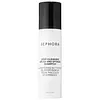What's inside
What's inside
 Key Ingredients
Key Ingredients

No key ingredients
 Benefits
Benefits

 Concerns
Concerns

 Ingredients Side-by-side
Ingredients Side-by-side

Water
Skin ConditioningCocamidopropyl Betaine
CleansingCocamide Mea
EmulsifyingPotassium Cocoyl Glycinate
PEG-7 Glyceryl Cocoate
EmulsifyingHexylene Glycol
EmulsifyingSodium Chloride
MaskingPolysorbate 20
EmulsifyingOlive Oil PEG-7 Esters
EmollientButylene Glycol
HumectantParfum
MaskingEthylhexylglycerin
Skin ConditioningCaprylhydroxamic Acid
Cetylpyridinium Chloride
AntimicrobialTropolone
Skin ConditioningCellulose
AbsorbentAlthaea Rosea Flower Extract
Skin ConditioningPerilla Frutescens Leaf Extract
MaskingPerilla Ocymoides Leaf Extract
TonicChamomilla Recutita Extract
Skin ConditioningGlycyrrhiza Glabra Root Extract
BleachingCentella Asiatica Extract
CleansingTaraxacum Officinale Leaf Extract
Skin ConditioningPanax Notoginseng Root Extract
HumectantSaponaria Officinalis Extract
Skin ConditioningBupleurum Chinense Root Extract
AstringentSalicornia Herbacea Extract
Skin ConditioningAlgae Extract
EmollientHizikia Fusiforme Extract
Skin ConditioningCodium Fragile Extract
Skin ConditioningWater, Cocamidopropyl Betaine, Cocamide Mea, Potassium Cocoyl Glycinate, PEG-7 Glyceryl Cocoate, Hexylene Glycol, Sodium Chloride, Polysorbate 20, Olive Oil PEG-7 Esters, Butylene Glycol, Parfum, Ethylhexylglycerin, Caprylhydroxamic Acid, Cetylpyridinium Chloride, Tropolone, Cellulose, Althaea Rosea Flower Extract, Perilla Frutescens Leaf Extract, Perilla Ocymoides Leaf Extract, Chamomilla Recutita Extract, Glycyrrhiza Glabra Root Extract, Centella Asiatica Extract, Taraxacum Officinale Leaf Extract, Panax Notoginseng Root Extract, Saponaria Officinalis Extract, Bupleurum Chinense Root Extract, Salicornia Herbacea Extract, Algae Extract, Hizikia Fusiforme Extract, Codium Fragile Extract
Water
Skin ConditioningSodium Cocoyl Isethionate
CleansingGlycerin
HumectantSodium Methyl Cocoyl Taurate
CleansingCoco-Betaine
CleansingPotassium Cocoyl Glycinate
Potassium Benzoate
PreservativeSodium Chloride
MaskingPolyquaternium-67
Potassium Cocoate
EmulsifyingCitric Acid
BufferingFructooligosaccharides
HumectantSaccharide Hydrolysate
HumectantDisodium EDTA
Pullulan
1,2-Hexanediol
Skin ConditioningAllantoin
Skin ConditioningPanthenol
Skin ConditioningSea Water
HumectantSodium Acetate
BufferingButylene Glycol
HumectantChamomilla Recutita Flower Oil
MaskingCaprylic/Capric Triglyceride
MaskingBeta-Glucan
Skin ConditioningPhosphatidylcholine
EmulsifyingHyaluronic Acid
HumectantEthylhexylglycerin
Skin ConditioningCeramide NP
Skin ConditioningGlycine
BufferingHydrolyzed Hyaluronic Acid
HumectantGlutamic Acid
HumectantSerine
MaskingSodium Hyaluronate
HumectantLysine
Skin ConditioningAlanine
MaskingArginine
MaskingThreonine
Proline
Skin ConditioningWater, Sodium Cocoyl Isethionate, Glycerin, Sodium Methyl Cocoyl Taurate, Coco-Betaine, Potassium Cocoyl Glycinate, Potassium Benzoate, Sodium Chloride, Polyquaternium-67, Potassium Cocoate, Citric Acid, Fructooligosaccharides, Saccharide Hydrolysate, Disodium EDTA, Pullulan, 1,2-Hexanediol, Allantoin, Panthenol, Sea Water, Sodium Acetate, Butylene Glycol, Chamomilla Recutita Flower Oil, Caprylic/Capric Triglyceride, Beta-Glucan, Phosphatidylcholine, Hyaluronic Acid, Ethylhexylglycerin, Ceramide NP, Glycine, Hydrolyzed Hyaluronic Acid, Glutamic Acid, Serine, Sodium Hyaluronate, Lysine, Alanine, Arginine, Threonine, Proline
 Reviews
Reviews

Alternatives
Ingredients Explained
These ingredients are found in both products.
Ingredients higher up in an ingredient list are typically present in a larger amount.
Butylene Glycol (or BG) is used within cosmetic products for a few different reasons:
Overall, Butylene Glycol is a safe and well-rounded ingredient that works well with other ingredients.
Though this ingredient works well with most skin types, some people with sensitive skin may experience a reaction such as allergic rashes, closed comedones, or itchiness.
Learn more about Butylene GlycolEthylhexylglycerin (we can't pronounce this either) is commonly used as a preservative and skin softener. It is derived from glyceryl.
You might see Ethylhexylglycerin often paired with other preservatives such as phenoxyethanol. Ethylhexylglycerin has been found to increase the effectiveness of these other preservatives.
Potassium Cocoyl Glycinate is an amino acid-based surfactant and cleaning agent. This ingredient can be derived from animals or plants. It may also be synthetically created from fatty acids of the coconut and glycine.
Potassium Cocoyl Glycinate is a gentle surfactant. Surfactants help gather the dirt, oil, and other pollutants from your skin to be rinsed away. It is a mild cleanser and naturally produces foam.
Chances are, you eat sodium chloride every day. Sodium Chloride is also known as table salt.
This ingredient has many purposes in skincare: thickener, emulsifier, and exfoliator.
You'll most likely find this ingredient in cleansers where it is used to create a gel-like texture. As an emulsifier, it also prevents ingredients from separating.
There is much debate on whether this ingredient is comedogenic. The short answer - comedogenic ratings don't tell the whole story. Learn more about comegodenic ratings here.
The concensus about this ingredient causing acne seems to be divided. Research is needed to understand if this ingredient does cause acne.
Scrubs may use salt as the primary exfoliating ingredient.
Learn more about Sodium ChlorideWater. It's the most common cosmetic ingredient of all. You'll usually see it at the top of ingredient lists, meaning that it makes up the largest part of the product.
So why is it so popular? Water most often acts as a solvent - this means that it helps dissolve other ingredients into the formulation.
You'll also recognize water as that liquid we all need to stay alive. If you see this, drink a glass of water. Stay hydrated!
Learn more about Water